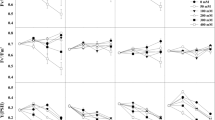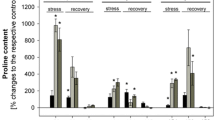Abstract
We compared the parameters of chlorophyll fluorescence between two sugar beet (Beta vulgaris L.) species differing in drought tolerance. Our results indicated that there were different responses to the drought stress of these sugar beet species. In drought-tolerant sugar beet, the F 0 increased slightly, while qN increased substantially, indicating that these plants can protect PSII reaction centers from the damage. F v/F m and qP decreased slightly during the initial period of drought stress; this suggests that there is a slight impact of drought stress on the openness of PSII reaction centers, and thus the plants did not suffer seriously. This was further shown by the decreased Yield and electron transfer rate. The parameters of chlorophyll fluorescence were stable and can be used as an important indicator for sugar beet seedlings in the early drought tolerance.
Similar content being viewed by others
Abbreviations
- Chl:
-
chlorophyll
- F 0 :
-
minimal fluorescence yield
- F m :
-
maximal fluorescence values
- F s :
-
steady-state Chl fluorescence
- F v/F m :
-
maximum photochemical efficiency of PSII
- ETR:
-
electron transport rate
- Yield:
-
actual photochemical efficiency of PSII
- qP:
-
photochemical quenching
- qN:
-
non-photochemical quenching
- PSII:
-
photosystem II
- PSI:
-
photosystem I
References
Trenberth, K., Atmospheric Moisture Residence Times and Cycling Implications for Rainfall Rates and Climate Change, Climatic Change, 1998, vol. 39, pp. 667–694.
Li, X.B., Chen, Y.H., and Zhang, Y.X., Impact of Climate Change on Desert Steppe in Northern China, Adv. Earth Sci., 2002, vol. 17, pp. 254–261.
Boyer, J.S., Plant Productivity and Environment, Science, 1982, vol. 218, pp. 443–448.
Pimentel, D., Houser, J., Preiss, E., White, O., Fang, H., Mesnick, L., Barsky, T., Tariche, S., Schreck, J., and Alpert, S., Water Resources: Agriculture, the Environment and Ethics, Ecological Sustainability and Integrity, Lemon, J., Ed., Dordrecht: Kluwer, 1998, pp. 104–134.
Jaggard, K.W., Dewar, A.M., and Pidgeon, J.D., The Relative Effects of Drought Stress and Virus Yellows on the Yield of Sugar Beet in the UK, 1980–1995, J. Agric. Sci., 1998, vol. 130, pp. 337–343.
Pidgeon, J.D., Werker, A.R., Jaggard, K.W., Richter, G.M., Lister, D.H., and Jones, P.D., Climatic Impact on the Productivity of Sugar Beet in Europe, 1961–1995, Agric. Meteorol., 2001, vol. 109, p. 27–37.
Jones, P.D., Lister, D.H., Jaggard, K.W., and Pidgeon, J.D., Future Climate Change Impact on the Productivity of Sugar Beet (Beta vulgaris L.) in Europe, Climatic Change, 2003, vol. 58, pp. 93–108.
Guo, W.H., Li, B., Huang, Y.M., Zhao, H.X., and Zhang, X.S., Effects of Different Water Stresses on Ecophysiological Characteristics of Hippophaer hamnoides Seedlings, Acta Bot. Sinica, 2003, vol. 45, pp. 1238–1244.
He, Y.H., Guo, L.S., and Tian, Y.L., Photosynthetic Rates and Chlorophyll Fluorescence of Nitraria tangutorum at Different Leaf Water Potentials, Acta Bot. Boreal-Occident Sinica, 2005, vol. 25, pp. 2226–2233.
Ober, E.S., Bloa, M.L., Clark, C.J.A., Royal, A., Jaggard, K.W., and Pidgeon, J.D., Evaluation of Physiological Traits as Indirect Selection Criteria for Drought Tolerance in Sugar Beet, Field Crops Res., 2005, vol. 91, pp. 231–249.
Krause, G.H. and Weis, E., Chlorophyll Fluorescence and Photosynthesis: The Basics, Annu. Rev. Plant Physiol. Plant Mol. Biol., 1991, vol. 42, pp. 313–349.
Zhang, S.R., A Discussion on Chlorophyll Fluorescence Kinetics Parameters and Their Significance, Chin. Bull. Bot., 1999, vol. 16, pp. 444–448.
Binder, W.D. and Fielder, P., Chlorophyll Fluorescence as an Indicator of Frost Hardiness in White Spruce Seedlings from Different Latitudes, New Forests, 1996, vol. 11, pp. 233–253.
Maxwell, K. and Johnson, G.N., Chlorophyll Fluorescence: A Practical Guide, J. Exp. Bot., 2000, vol. 51, pp. 659–668.
Ehlert, B. and Hinvha, D.K., Chlorophyll Fluorescence Imaging Accurately Quantifies Freezing Damage and Cold Acclimation Responses in Arabidopsis Leaves, Plant Methods, 2008, vol. 4, pp. 1–7.
Van Kooten, K.O. and Snel, J.F.H., The Use of Chlorophyll Nomenclature in Plant Stress Physiology, Photosynth. Res., 1990, vol. 25, pp. 147–150.
Xu, C.C., Jeon, J.A., and Lee, C.H., Relative Contributions of Photochemical and Non-Photochemical Routes to Excitation Energy Dissipation in Rice and Barley Illuminated at a Chilling Temperature, Physiol. Plant., 1999, vol. 107, pp. 447–453.
Krall, J.P. and Edward, G.E., Relationship between Photosystem II Activity and CO2 Fixation in Leaves, Physiol. Plant., 1992, vol. 86, pp. 180–187.
Martínez-Carrasco, R., Sánchez-Rodriguez, J., and Pérez, P., Changes in Chlorophyll Fluorescence during the Course of Photoperiod and in Response to Drought in Casuarina equisetifolia Forst. and Forst, Photosynthetica, 2002, vol. 40, pp. 363–368.
Michal, K., David, K., and Ladislav, N., On the Relation between the Non-Photochemical Quenching of Chlorophyll Fluorescence and Photosystem I Light Harvesting Efficiency — a Repetitive Flash Fluorescence Induction Study, Photosynth. Res., 2001, vol. 68, pp. 571–576.
Björkman, O. and Demmig, B., Photon Yield of O2 Evolution and Chlorophyll Fluorescence Characteristics at 77K among Vascular Plants of Diverse Origins, Planta, 1987, vol. 170, pp. 489–504.
Hampton, J.G. and Tekrony, D.M., Handbook of Seed Vigour Test Methods, Zurich (Switzerland): International Seed Testing Association, 1995.
Golding, A.J. and Johnson, G.N., Down-Regulation of Linear and Activation of Cyclic Electron Transport during Drought, Planta, 2003, vol. 218, pp. 107–114.
Saǧlam, A., Saruhan, N., Terzi, R., and Kadioǧlu, A., The Relations between Antioxidant Enzymes and Chlorophyll Fluorescence Parameters in Common Bean Cultivars Differing in Sensitivity to Drought Stress, Russ. J. Plant Physiol., 2011, vol. 58, pp. 60–68.
Zhang, L.P., Jing, Q., Dai, T.B., Jiang, D., and Cao, W.X., Effects of Temperature and Illumination on Flag Leaf Photosynthetic Characteristics and Senescence of Wheat Cultivars with Different Grain Quality, Chin. J. Appl. Ecol., 2008, vol. 19, pp. 311–316.
Author information
Authors and Affiliations
Corresponding author
Additional information
This text was submitted by the authors in English.
Rights and permissions
About this article
Cite this article
Li, G.L., Wu, H.X., Sun, Y.Q. et al. Response of chlorophyll fluorescence parameters to drought stress in sugar beet seedlings. Russ J Plant Physiol 60, 337–342 (2013). https://doi.org/10.1134/S1021443713020155
Received:
Published:
Issue Date:
DOI: https://doi.org/10.1134/S1021443713020155




